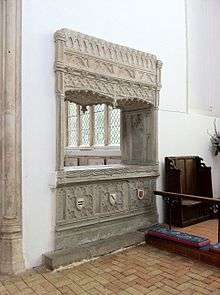John Hopton (died 1478)
John Hopton (about 1405-1478) was an English landowner and administrator with estates in Suffolk and Yorkshire who was active in local government during the reigns of King Henry VI and King Edward IV.[1]
Origins
He was a son of Thomas Hopton (died before 1428) and his wife Margaret, daughter of William Pert of Terrington (Tiverington in old documents placenames.org.uk ) and his wife Joan Scrope. His father was the illegitimate child of Joan Hopton, from a gentry family with lands near Swillington, and his paternal grandfather was Sir Robert Swillington, Chamberlain of the Household to John of Gaunt.[1]
Career
The young John had no particular prospects until a series of deaths left him in 1430, aged about 25, owner of two valuable holdings inherited from his grandfather. One was the lands of Swillington outside Leeds and the other was the estate of Westwood at Blythburgh. He made Westwood his home for the rest of his life, adding to his Suffolk holdings by the purchase of two further estates. One was Cockfield Hall in Yoxford, which he bought from Sir John Fastolf, and the other was Easton Bavents, just north of Southwold and mostly vanished under the sea, from Ela, widow of Sir Robert Shardlow.[1]
Early in his time in Suffolk he was chosen as sheriff for the county in 1436–7 and later served another term in 1444–5. From that year he also sat on the commission of the peace, leaving the bench in 1458 but being reappointed from 1461 until 1468, when the loss of his sight made him unable to continue. While his eldest son became Sir William, he himself refused a knighthood. His will has not survived, though he is known to have made one, and in 1478 he was buried beside his first wife in Holy Trinity Church, Blythburgh.[1]

Family
In 1427 he married Margaret, daughter of Sir Thomas Savile of Thornhill and his wife Margaret, daughter of Sir John Pilkington, with whom he had four sons and three daughters. The girls all married landowners,[1] for example Elizabeth who married Sir William Brewes of Stinton Hall in Salle.[2] After Margaret died in 1451, he founded a chantry for her in Blythburgh church and put up a tomb there for her and himself.[1]
Sources vary over his next marriage, some saying that between 1451 and 1457 he married and lost Agnes Heveningham.[3] However it is certain that in 1457 he married Thomasine, daughter of John Barrington of Rayleigh and his wife Isabel. She was the widow of two previous husbands, William Lunsford of Battle and William Sidney of Stoke d'Abernon, and already had seven children. Together they had two sons and she long outlived him, being buried near him in Blythburgh church in 1498.[1]
References
- 1 2 3 4 5 6 7 Richmond, Colin (2010). "Hopton, John (c.1405–1478)". Oxford Dictionary of National Biography (online ed.). Oxford University Press. doi:10.1093/ref:odnb/101227. (Subscription or UK public library membership required.)
- ↑ Blomefield, Francis (1808), "Eynford Hundred: Stinton", An Essay Towards A Topographical History of the County of Norfolk, 8, London, pp. 266–269, retrieved 26 March 2017
- ↑ Richardson, Douglas (2011), Magna Carta Ancestry: A Study in Colonial and Medieval Families (2 ed.), retrieved 27 March 2017
Bibliography
Richmond, Colin. John Hopton: A Fifteenth Century Suffolk Gentleman; Cambridge University Press, 2005.